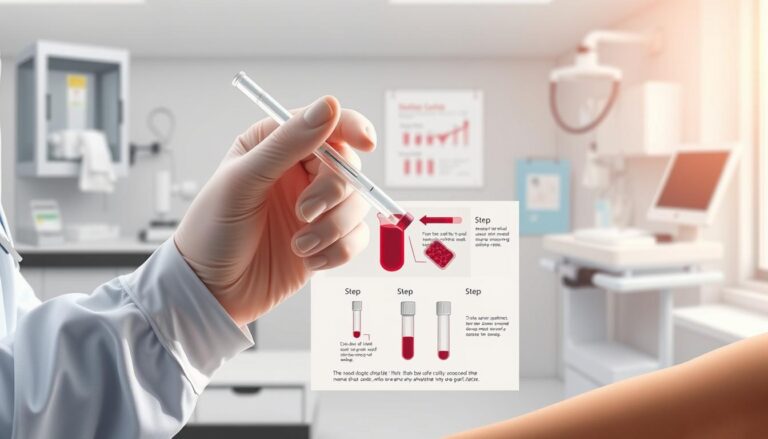What Causes Hemolyzed Blood Samples and How to Prevent Them
Ever wondered why blood samples sometimes get messed up, leading to wrong test results and delayed care? It’s all about knowing what causes hemolyzed blood samples. This can happen for many reasons, like bad blood collection methods and damage during transport.
In the world of lab tests, hemolyzed blood is a big problem, even more so in emergency rooms. Things like shaking tubes too much and using big needles increase the risk. This shows why we need to stop hemolysis and understand its causes.

When blood samples are visibly damaged, it can mess up test results. Too much hemoglobin can also cause problems in some tests. So, stopping hemolysis and knowing why it happens is key. It helps labs get accurate results faster, which is better for patients at our diagnostic centre in Yelahanka, we follow strict protocols to prevent hemolysis, ensuring precise and reliable test results for better patient care.
Understanding Blood Sample Hemolysis
We must understand how hemolysis affects test results for accurate lab findings. Hemolysis in blood samples can skew Cardiac troponin [cTn] levels. This can make it hard to spot heart condition markers in patients.
Hemolyzed blood can cause inaccurate lab results, delayed diagnosis, and wrong treatments. It’s crucial to handle blood samples carefully to avoid these issues.
Lab tests can be off when blood is hemolyzed. This is because of the release of cell contents, dilution, and interference with tests. To fix this, we need to use the right collection and storage methods. Treating hemolyzed blood requires special care to avoid more damage.
Hemolysis can really mess with lab results, affecting tests for Trace Minerals and Serum. It can change iron, magnesium, potassium, and sodium levels. To stop hemolysis, we should use the right needle, let alcohol dry, and move blood gently into tubes.
- Use the correct gauge needle for blood collection
- Allow alcohol to dry before drawing blood
- Gently transfer blood into the collection tube
- Follow specific tube inversion and storage procedures
By knowing how hemolysis affects tests and using the right techniques, we can get accurate lab results. This helps us care for patients better.
| Test Type | Effect of Hemolysis |
|---|---|
| Cardiac troponin [cTn] levels | Bias in test results |
| Trace Mineral and Serum testing | Alteration of concentrations of iron, magnesium, potassium, and sodium |
Common Causes of Hemolyzed Blood Samples
Hemolyzed blood samples are common in medical testing. They can cause inaccurate results and delay diagnosis. Several factors contribute to hemolysis, including wrong collection methods, mechanical damage, and more.
Hemolysis can greatly affect lab tests, leading to sample rejection and re-testing. In emergency departments, up to 20% of samples are contaminated due to hemolysis. Knowing the causes of hemolyzed blood samples is key to reducing risks and ensuring accurate diagnoses.
Some common causes of hemolyzed blood samples include:
- Defective red blood cells
- Immune system-related conditions
- Infections
- Medications
- Pregnancy complications
External factors like poisons, high blood pressure, and overactive spleen conditions also cause hemolysis. By understanding these causes, we can prevent hemolysis and get accurate lab results.
Essential Prevention Techniques and Best Practices
It’s vital to prevent hemolysis in blood samples for accurate lab results. Techniques like proper collection methods can lower hemolysis risk. Handling hemolyzed samples right, like keeping transport short and using inserts, is also key.
Following the right collection steps is crucial. This includes picking the right spot for blood draw and using the right tools. Keeping samples at the right temperature and avoiding shaking them helps too.
Choosing good equipment and keeping it in top shape is important. Training staff, like phlebotomists, is also critical. By doing these things, we can cut down on hemolysis and get better lab results.
Proper Collection Methods
- Select a viable site for venipuncture
- Use appropriate needles and syringes
- Minimize the length and speed of transport
Storage and Transportation Guidelines
- Keep samples at the correct temperature
- Avoid vigorous mixing
- Use cushion inserts in carrier tubes
Conclusion: Maintaining Sample Integrity in Clinical Practice
Keeping samples intact in clinical practice is key for accurate lab results and timely patient care. Hemolyzed blood samples can greatly affect treatment. It’s vital to know how hemolyzed samples impact care and use methods to prevent them.
By following the prevention techniques and best practices mentioned, we can improve blood sample analysis. This helps keep samples reliable.
Lab specialists must also talk clearly with doctors about samples that have been affected by hemolysis. Working together, we can lower the number of hemolyzed samples. This teamwork improves patient care.
Through ongoing efforts in preventing hemolysis and ensuring sample quality, we make lab data more reliable. This boosts the success of clinical practice.







